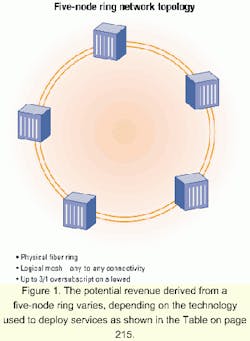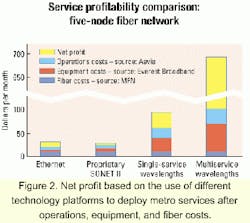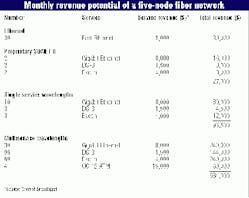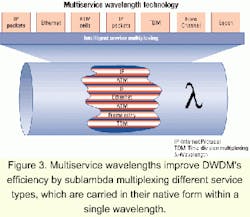Despite the talk about a fiber glut, wavelengths don't come cheap in metropolitan-area networks.
ROBERT M. LEFKOWITS, Alidian Networks
Fiber is still a precious commodity to metropolitan-area-network (MAN) providers, despite all the dark fiber in the ground. Service providers require a highly flexible metro technology that squeezes every drop out of their fiber facilities. The technology must support existing and future services, some of which haven't even been imagined yet. Instead of trying to retrofit SONET voice infrastructures to handle increasingly data-dominated traffic flows, or attempting to adapt long-haul DWDM technology to the MAN for high-speed Internet access, service providers should move to a protocol-agnostic platform. With an intelligent service-multiplexing architecture, multiple services-ATM, Internet Protocol, 100-Mbit/sec Ethernet, Gigabit Ethernet, frame relay, legacy time-division multiplexing (TDM)/SONET, packet over SONET (PoS), and even back-end data-center services such as Escon and Fibre Channel-can be provisioned dynamically on a single wavelength.
This "sublambda multiplexing" eliminates the bandwidth mismatches that waste a lot of capacity when each wavelength has to be dedicated to a particular type of service. The different protocols are supported in native mode so that service providers are spared the complexity, cost, and potential latency of protocol conversion. Bandwidth previously eaten up by overhead can be reclaimed and used for revenue-generating services.
The price/performance of optical-networking technology is in a freefall that puts the Moore's Law governing microprocessor technology to shame. In stark contrast, fiber represents a long-term fixed cost. Service providers building out MANs are paying between $500 and $1,000 per month per mile for each leased pair of fiber strands. Generally, service providers must commit to 20- or 25-year contracts that cannot be transferred.
In downtown areas, the cost of connecting two nodes averages about $2,000, so leasing a five-node ring as shown in Figure 1 is $10,000 per month or $120,000 per year. Over the course of a 25-year lease, the service provider will have to shell out $3 million. This sunk cost can be reduced only in relative terms by provisioning more revenue-generating services on the same fiber facilities.If the five-node ring is dedicated to Fast Ethernet (100-Mbit/sec) services, the service provider may use it to support approximately 30 point-to-point access links. The total revenue generated by this single-service Ethernet MAN is $30,000 per month. Relatively low operational costs enable the service provider to make a $7,500 profit (see Figure 2). But, because no other services can be supported on this fiber, there is no upside potential for additional revenue that could lead to improved profits.
Clearly, multiservice MANs do a much better job of leveraging the fixed costs of fiber than infrastructures that support only a single service. However, there is more than one way to implement a multiservice MAN, and the service provider pioneers that are doing so have three technologies to choose from: proprietary SONET II, single-service wavelengths, or native-mode multiservice wavelengths.
Proprietary SONET II. Most MANs today are based on SONET TDM, which was designed to aggregate voice traffic onto fiber cables. Bursty data traffic doesn't fit very efficiently into SONET's rigid time slots, which are too inflexible to support a dynamic multiservice environment. To address this problem, many SONET equipment vendors have developed their own proprietary versions of SONET II. SONET II typically supports multiple topologies, enables more efficient ring interconnection, and uses a proprietary form of virtual concatenation to support high-speed data circuits. Virtual concatenation technology can be used to group any number of STS-1 (52-Mbit/sec) or AU4 channels into a "super circuit." These channels can be resized as needed to provide bandwidth on demand, giving the service provider much finer TDM provisioning granularities.
Virtual concatenation gives SONET some much-needed flexibility, and it can be used to deliver multiple services over the same fiber. It is also compatible with existing SONET networks. For networks in which the majority of circuits carry TDM voice traffic with a small amount of data, SONET II works well.However, because SONET II is still switching circuits rather than packets, it wastes a lot of bandwidth when the majority of the traffic is data. Also, SONET standards for virtual concatenation are still being defined; therefore, each SONET II equipment vendor's current implementation of virtual concatenation technology is proprietary.
When SONET II-based MANs do run out of capacity, service providers face expensive upgrade options. They can either increase the capacity of all the add/drop multiplexing (ADM) elements to a higher level in the OC-N hierarchy (e.g., from OC-48 to OC-192), or build or lease a new concentric ring that runs at the same or a higher speed. The first option is the notorious "forklift" upgrade; it requires ADMs that support in-service upgrades-many do not-and entails a huge capital expenditure.
A few SONET II systems can support Gigabit Ethernet data connections, but a service provider that uses one of these systems to provision such services will have trouble making a profit. As shown in Figures 1 and 2, because each Gigabit Ethernet connection reserves 20 of the 48 STS-1 groups available, only eight STS-1s remain available for other services after two gigabit connections are created. Even if these remaining STS-1s are used to offer high-revenue services such as DS-3s (44.736 Mbits/sec) and Escon, revenue is limited to less than $30,000 per month and profits are a minimal $2,000.
Single-service wavelengths. Because SONET is inherently an inefficient purveyor of data services, the network industry has begun adapting transparent DWDM to the MAN environment. These highly scalable products enable service providers to light up new wavelengths on the same fiber. Such "virtual fibers" can be deployed in days, and they eliminate or at least postpone the need to build out a new fiber ring-a costly, time-consuming, and sometimes, impossible task.
Instead of using nailed-up SONET circuits to connect each node, DWDM uses a different wavelength of light (also called a lambda, or "l") to provision each service. Each wavelength can carry a service at speeds ranging from 50 Mbits/sec to a full 2.5 Gbits/sec. However, like SONET, transparent DWDM was designed with a different role in mind: carrying long-haul traffic efficiently from point to point. The economics of the MAN are very different because of widely varying topologies, traffic patterns, and a much greater number of add/drop points. Although transparent DWDM in the metro area has some clear advantages over SONET, it is still bandwidth inefficient. It requires an entire wavelength for each service it carries. For example, using transparent DWDM to provision a Fast Ethernet service wastes 2,400 Mbits/sec of the 2,500 Mbits/sec of bandwidth available on the wavelength-96% is wasted.
Using transparent DWDM on the hypothetical five-node ring does show some economic benefits when compared to single-service Ethernet and proprietary SONET II. With DWDM, 16 high-speed services can be provisioned on a 16-wavelength fiber. Since multiple Gigabit Ethernet services can exist on the same fiber, revenue potential is significantly higher than the non-DWDM technologies-up to $96,500 per month in the example. Profits are also quite reasonable at almost $30,000 per month.
Multiservice wavelengths. While Ethernet, proprietary SONET II, and transparent DWDM may each have its place in niche-market networks, each technology clearly falls short as a general-purpose solution for today's MAN. A new approach combines the best features of these platforms while eliminating their shortcomings-multiservice wavelengths. Multiservice wavelengths are enabled by a protocol-independent switching technology that can carry any type of service currently available in the MAN, or likely to appear, including ATM, legacy TDM/SONET, PoS, Fast Ethernet, Gigabit Ethernet, 10-Gigabit Ethernet, frame relay, and back-end data-center services such as Escon and Fibre Channel.
All these services are supported in their native modes, so there is no need to translate services into a common protocol such as ATM or Ethernet. A lot of expensive intermediate gear in the carrier infrastructure is eliminated, which saves money and reduces latency. At the same time, multiservice wavelengths inherit the fault-management and protection mechanisms of a SONET-framed transport, so customers get the same reliability they have come to expect from SONET service.
Multiservice wavelengths use DWDM, greatly improving its efficiency with sublambda multiplexing. Different service types-ATM, Ethernet, PoS, etc.-can be carried in their native form within a single wavelength, enabling service providers to take full advantage of available bandwidth (see Figure 3). This ability to do "wavelength packing" lets carriers provision more services on the same fiber, and in turn, generate more revenue. Additional benefits include dynamic provisioning, quality of service, and wavelength switching.In the Internet economy, businesses often grow at dizzying speeds, and some crash and burn just as fast. MAN service providers need an infrastructure that accommodates the rapidly changing bandwidth requirements of these enterprises, and equipment that can create multiservice wavelengths raises provisioning flexibility to a new level. Service providers with a multiservice-wavelength infrastructure can dynamically pre-provision services so that customers can ratchet up bandwidth consumption as needed. It is even possible to implement a multiservice-wavelength environment, which allows customers to self-provision bandwidth.
A rapidly growing business that wants an Ethernet connection and currently needs less than 100 Mbits/sec of bandwidth can be set up with a Gigabit Ethernet connection. Meanwhile, the service provider can use the rest of the Gigabit bandwidth to provision services to other customers, even if those services are not Ethernet. As the first customer starts consuming additional bandwidth, the other customers can be switched to a different wavelength.
All customers and traffic types in the MAN are not created equal, and as such, they should not be treated the same. Service providers need to deal with the different types of traffic profitably and within expected service parameters. Multiservice-wavelength equipment can look into the different services within a wavelength, recognize service classes, and maintain the various service levels required by traffic types and service-level agreements.
Multiservice wavelengths also address the add/drop inefficiencies of transparent DWDM. Again, add/drop capabilities weren't important in long-haul networks where traffic was being transported from point to point. In the MAN, transparent DWDM equipment throws wavelengths at the problem, using a separate wavelength for each drop point. This solution quickly becomes prohibitively complex and expensive as the number of nodes on a metro ring increases.
A multiservice-wavelength infrastructure enables service providers to switch services between wavelengths and add/ drop services at multiple nodes, which conveys a number of important advantages. Fewer wavelengths have to be lit up on each ring, allowing greater spacing between wavelengths, and the equipment can be manufactured with lower-cost, more readily available components. Also, newly added services can be switched onto available bandwidth, wherever it might occur at any point in time. Similarly, bandwidth modifications to existing services can be accommodated by switching those services to an available wavelength.
Most importantly, multiservice wavelengths let the service provider reach profitability; using multiservice-wavelength technology enables a provider to support almost 200 services on a single fiber pair. The provider can offer its customers very competitive pricing while still pulling in more than $650,000 in monthly revenue. Even with somewhat higher monthly costs, the multiservice-wavelength service provider can look forward to profits that top a half-million dollars per month and gross margins that exceed 80%.
With all of the service nodes for end customers in metro networks, the equipment at all of the add/drop points is the main cost. Service providers must also commit to long-term, non-transferable contracts for the fiber itself. Given these economic realities, MAN providers need an infrastructure that can deliver multiple services on the same fiber. Thus, service providers need to evaluate optical-networking technologies in terms of their suitability for multiservice delivery.
Attempts to turn SONET, long-haul DWDM, and Ethernet technologies into multiservice MAN platforms result in wavelength-burning networks that tap only a fraction of the fiber's full capacity. Multiservice wavelengths address this problem. This technology offers service providers a MAN infrastructure that can provision multiple services dynamically on a single wavelength and also support new services as they arise. These benefits are delivered while maintaining SONET-grade fault management and DWDM scalability.
With a multiservice-wavelength platform, service providers don't have to worry about predicting the relative demand for TDM and various data services as the Internet economy evolves. The use of multiprotocol wavelengths and wavelength switching creates an unprecedented topology flexibility that is ideal for the very dynamic and heterogeneous MAN environment. The breadth of services that can be delivered prepares MAN providers for whatever the future may hold.
Robert M. Lefkowits is vice president of marketing at Alidian Networks (San Jose, CA). He can be reached via the company's Website, www.alidian.com.




